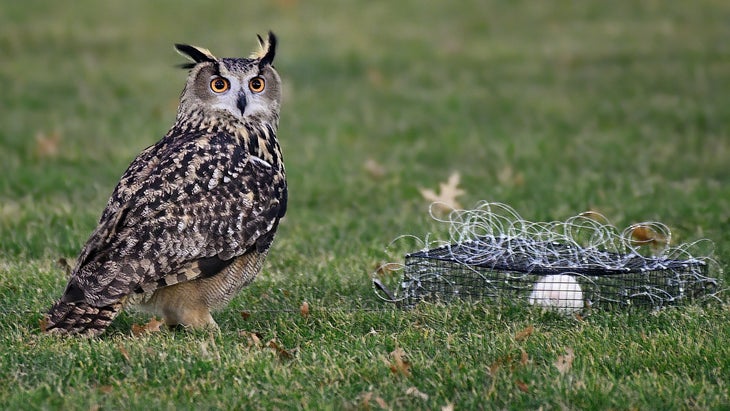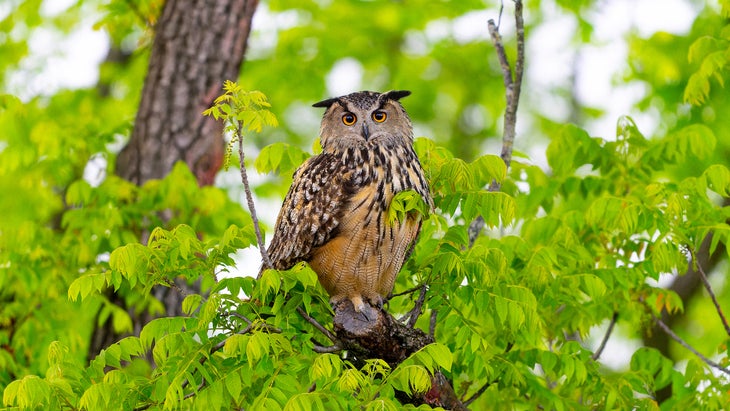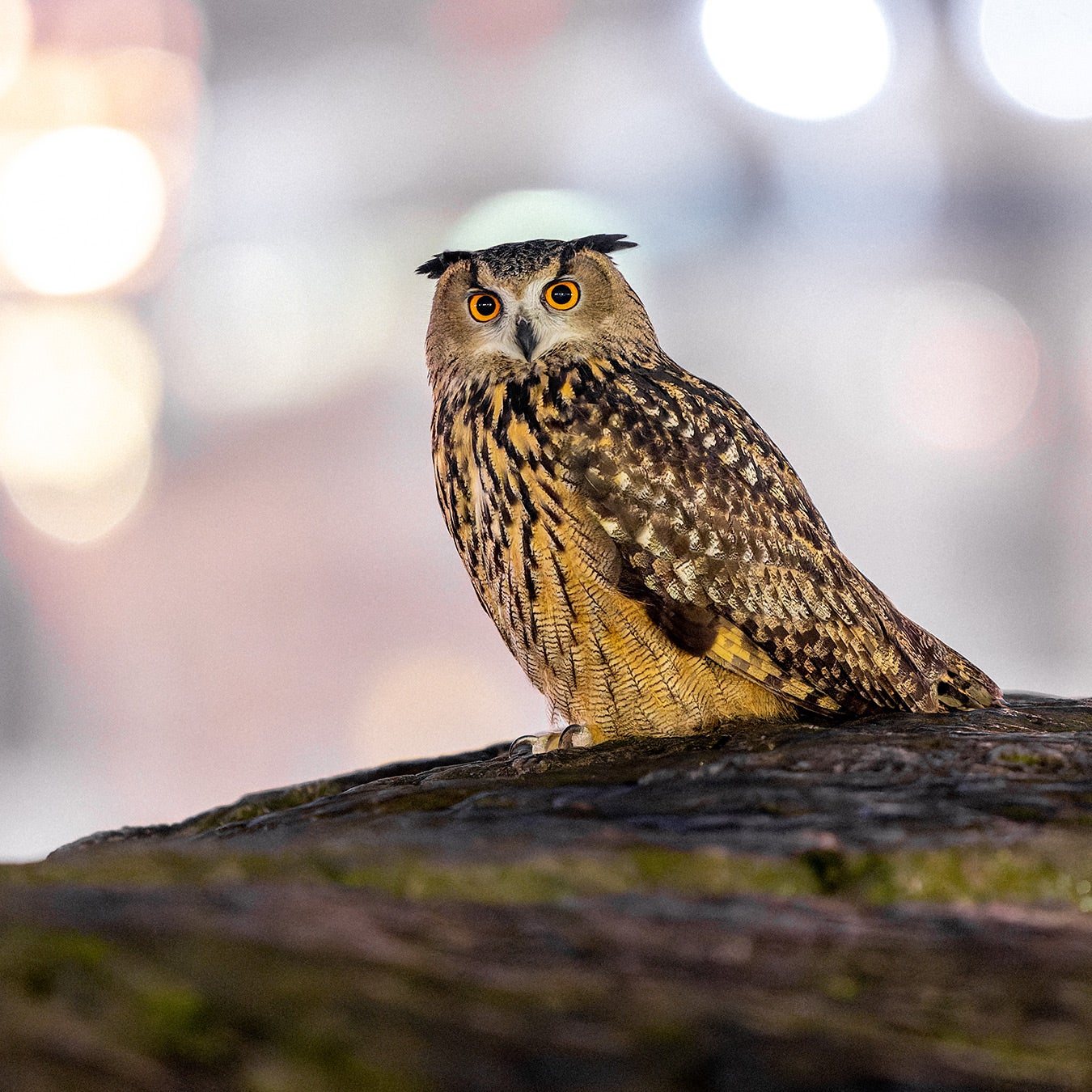Flaco is dead. Long live Flaco.
In case you were unaware, one of the most whimsical and curious stories in the recent memory of New Yorkers came to an abrupt and sad end last Friday, February 23. A building superintendent on Manhattan’s Upper West Side discovered the body of Flaco, a massive Eurasian eagle owl who had escaped from the Central Park Zoo in early 2023 and then spent more than a year roaming the city, well, free as a bird. Officials performed an initial necropsy on the deceased owl, which showed it died of acute traumatic injury, likely the result of flying into a building. Additional testing for the presence of rodenticides, other toxins, or diseases is still being performed.
Flaco had been been raised in captivity and he was freed by a brazen act of vandalism—someone had intentionally shredded the protective zoo netting of his enclosure. The crime generated a handful of news stories, including this one in The New York Times. What happened next seemed to catch everyone—including Times writers—off guard. Flaco set up residence in Central Park, and curious New Yorkers adopted him as an unofficial mascot of the city. Crowds formed whenever Flaco perched in a tree. Photos of him napping on fire escapes or rooftops flooded social media. News outlets covered his every move—like when he learned to hunt rats and triumphantly barfed up his first owl pellet. Each new Flaco development generated more buzz.
Throughout 2023 and into 2024, the Times ran an entire series of stories on Flaco and his fanatical followers. Why do people love him? How did he become a folk hero? How long could he survive? There were many Flaco questions, and the Times sought to answer them all. Much of the coverage was either written or edited by Ed Shanahan, a veteran reporter and editor of breaking news on the Times’ Metro desk. Shanahan edited the news story announcing Flaco’s freedom, and he wrote the one announcing his death, among other pieces. I recently called him up to try and understand why a feathery owl so thoroughly captivated New Yorkers and the city’s official newspaper of record.

Outside: How did you get on the Flaco beat? Did you raise your hand for the assignment or just routinely stumble into it?
Shanahan: I edited the initial news story. It was a typical Friday and we had heard about this owl being let loose from the zoo, and it seemed like such an unusual occurrence. It’s a crime story, so there’s going to be that attention on it. It’s an animal out of captivity, so I wondered if they can get him back. Then, I kept an eye on Twitter over the course of the first week, and there were people photographing Flaco and posting images there, so it was easy enough to see what developments were going on. After the first week, it seemed like there was not going to be a quick and easy resolution to this, and the mere fact of him remaining on the loose made it compelling to me. I guess I made enough of a case to my boss that was like: Hey, let’s do an update here.
Why do you think so many people were interested in the initial news stories?
There is an active and growing birding community in the city that got turbocharged during the pandemic. They are extremely active online, and this community very much latched on to Flaco. This gave me a sense that there was an audience for more coverage. Is it good for a bird to be out there? Would he be better off in the zoo? These were questions that folks wanted to answer. Then, as time went on, Flaco started teaching himself to hunt, how to land on a branch, how to develop these skills, and that was also compelling. One time, when I went to check on the bird, there were a good number of people standing under the tree he was in. One woman said she had been at a dinner party, and the whole party had erupted in applause when they had seen on Twitter that Flaco had coughed up an owl pellet. I thought: There’s something going on here.

New York City has a long history of captiving animal stories, from the tiger in an apartment, to the Gowanus Canal dolphin, to Pizza Rat. Why do you think Flaco in particular connected with readers on an emotional level?
I think it has a lot to do with how he got out of the zoo. He had gone from captivity to something like freedom—the idea of him having been in a cage his whole life, and now he’s out on his own and has to stand on his own two talons. He had to do things he’d never done, like hunt. It’s not like he had been free, and then taken into captivity, and was now just getting back to hunting and living in the wild. Also, you cannot discount the sheer magnificent beauty of the bird. Owls are so expressive with their front-facing eyes, and people generally are drawn to them. We have a lot of ideas about owls, like they are wise. He was also gigantic. Writing about animals is tricky, because people project things onto them. So you had Flaco the outlaw. Flaco the immigrant. I didn’t traffic in those ideas, but I can see how he had meaning for a lot of people.

I also wonder if his badass name helped capture attention. I wonder if as many people would have read about Doug the Owl.
Yes, it’s a great name and extremely catchy. I now know that, in Spanish, Flaco means skinny, and I think that was another part of him that was appealing. The bird was definitely not skinny. It’s like the big guy who people call “Tiny.” There was something funny about it.
I read online people saying it was just a matter of time before he was killed.
Yes. Based on the comments I got from experts, this was an extremely dangerous situation for the bird, and there were all of these threats he faced, even if he was able to learn how to eat and unleash his owl instincts. For people who know birds, they knew this about the situation. I don’t want to say he was doomed, but in a way he was. It was amazing that he lived as long as he did. Most experts told me that. For people who were not bird experts and latched onto Flaco for whatever inspirational value, I can understand why it’s hit so hard that he has died.
Video credit: David Lei
Every New York City story is a politics story. Did Flaco become a battleground?
A column was printed in The New York Post after he died that focused on the vandalism and the crime aspect, and how whomever did this did a disservice to Flaco. The writer took a dig at district attorney Alvin Bragg, who The Post says is soft on crime. Otherwise, there were a lot of people in the birding community who felt that the story wasn’t treated seriously enough. Flaco faced danger. He presented a danger to native species. There was a fear he might prey on the Peregrine falcons that live on the Upper West Side. But pretty much everyone was rooting for Flaco, no matter their background.
What does Flaco’s death represent within the wider scope of this story?
The hardened newsman in me sees his death as the likeliest outcome once he was placed in an unnatural and dangerous setting. He did a great job to last as long as he did. But I think it was preordained that he wasn’t going to die of old age.

